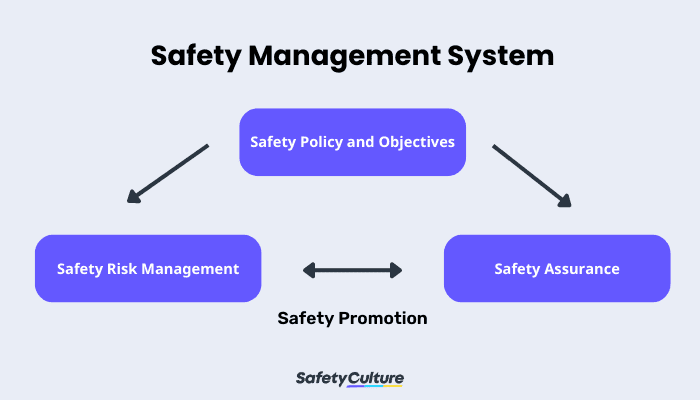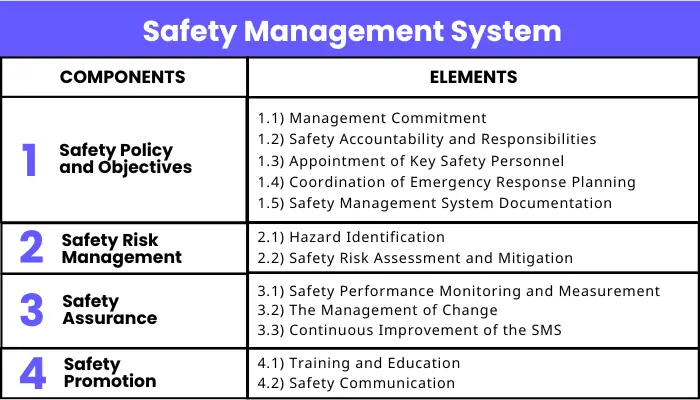What is Safety Management System?
Safety Management System (SMS) is a collection of structured, company-wide processes that provide effective risk-based decision-making for daily business functions. Safety Management Systems help organizations offer products or services at the highest level of safety and maintain safe operations. SMS can also serve as a formal means of meeting statutory requirements such as Title 14 of the U.S. Code of Federal Regulations (CFR) enforced by the Federal Aviation Administration (FAA). According to the International Civil Aviation Organization (ICAO), the key processes of a safety management system are hazard identification, occurrence reporting, risk management, performance measurement, and quality assurance.

Safety Management System | Learn more about Components and Elements
Purpose of Safety Management Systems
The main purpose of a safety management system is to provide a systematic approach to managing safety risks in operations. SMS also aims to improve safety by building on existing processes, demonstrating corporate due diligence, and reinforcing the overall safety culture. Effective safety management is crucial in continuing to operate and grow the business, especially in high-risk industries such as aviation, energy, maritime, and construction.
Safety Management System in Aviation
In the context of aviation, a safety management system encompasses service provider activities involved in safe aircraft operations, including organizational affairs such as legal, finance, and human resources. The concept of aviation safety management systems is clearly defined in the ICAO Doc 9859 or Safety Management Manual (SMM). Based on its latest version published in 2018, SMS implementation should correspond to the size of the company and the complexity of the products or services provided. Among other stakeholders, aviation professionals can also provide inputs depending on their potential impact on safety performance.
Responsible for the regulation and oversight of civil aviation within the United States, the FAA emphasizes that SMS will not require a separate safety department because it focuses on functional expectations by operational departments. Moreover, the FAA Safety Management System will not require a Quality Management System (QMS), but if the organization already has one, it should align with the SMS. This can also be used with an HSE management system.
The 4 Components and 12 Elements of a Safety Management System
SMS has four components in its framework which are often referred to as the Four Pillars of Safety Management System. As stated by the FAA, the 4 safety management system components are as follows:
Each SMS component contains elements that describe specific needs for the successful implementation and maintenance of a safety management system. Originated from ICAO, the 12 safety management system elements are:
- Management Commitment
- Safety Accountability and Responsibilities
- Appointment of Key Safety Personnel
- Coordination of Emergency Response Planning
- SMS Documentation
- Hazard Identification
- Safety Risk Assessment and Mitigation
- Safety Performance Monitoring and Measurement
- Management of Change
- Continuous Improvement of the SMS
- Training and Education
- Safety Communication
The components and elements of a safety management system can be best understood together as illustrated in this image:

Safety Management System Framework: 4 Components and 12 Elements by ICAO
SMS Component #1: Safety Policy and Objectives
Employers should make safety an integral part of company values, demonstrating their commitment daily. Specifically, top management needs to set safety goals as policy, while being visible and personally involved in meeting them. Safety accountability and responsibilities should be clearly defined such as the role of the leadership team to manage safety in the same way that they oversee other areas of the business and the duty of technical managers to assure the effectiveness of safety risk controls.
Once appointed safety personnel have been identified, documentation processes should also be determined because the safety management system will be reviewed periodically to ensure it remains relevant and appropriate to the organization. As the FAA Safety Team (FAASTeam) shared, SMS documentation may be a stand-alone manual or integrated into existing record-keeping procedures.
SMS Component #2: Safety Risk Management
In order to effectively control safety risks, designated staff should perform a series of interconnected processes collectively called Safety Risk Management (SRM). It generally focuses on anticipating and mitigating risks at the process level. Listed below are the 5 steps that go into the safety risk management component of SMS:
- System Description and Task Analysis: As a system design function, system description and task analysis is used by a cross-functional team within the organization to state the facts about the activities and workplace conditions (equipment, environment, etc.) involved in their processes. Systems factors and attributes should also be considered such as procedures, process measures, and interfaces, among others.
- Hazard Identification: Hazards are identified as deficient conditions impacting activities which can result in injury, illness, or death to people and/or system, equipment, or property damages or losses. It is important to note that a hazard is any real or potential condition, including typical hazardous conditions related to human error such as time pressure, shift turnovers, and lack of system knowledge.
- Risk Analysis: Risks are derived from hazards based on the judgement of key safety personnel. Analyzing risk involves considering the likelihood and severity of adverse consequences. Since a single hazard can have multiple consequences, increased exposure to hazards can also make it more likely for grave consequences to recur. On the other hand, severity is mainly driven by the nature of the consequence itself.
- Risk Assessment: To assist with decision-making, perform a risk assessment and establish whether a safety risk is acceptable or not. A risk matrix is used as a tool for evaluating the combined effects of likelihood and severity, prioritizing which safety risks to address in what sequence for adequate resource allocation. If deemed acceptable, the SRM component of SMS is complete and the risk moves to the next component for monitoring. Otherwise, risk controls should be put in place to mitigate or reduce the risk.
- Risk Control: The safety management system element of risk control, also known as risk mitigation, enables the implementation of safety measures to safeguard people, property, or the environment. While the severity of risks may be lessened to a certain degree, decreasing their probability or likelihood is what happens in most situations. Risk controls applied to working conditions can be effective instruments for risk reduction and failure prevention.
| Risk Likelihood | Risk Severity | |||||
| Catastrophic A |
Hazardous B |
Major C |
Minor D |
Negligible E |
||
| Frequent | 5 | 5A | 5B | 5C | 5D | 5E |
| Occasional | 4 | 4A | 4B | 4C | 4D | 4E |
| Remote | 3 | 3A | 3B | 3C | 3D | 3E |
| Improbable | 2 | 2A | 2B | 2C | 2D | 2E |
| Extremely Improbable |
1 | 1A | 1B | 1C | 1D | 1E |
SMS Component #3: Safety Assurance
Safety Assurance (SA) is the component of safety management system that deals with the monitoring of risk controls during operations. After strategically placing control measures, their performance and effectiveness should be assessed as well. Common SA functions include internal audits, investigations, and employee reporting systems. Particularly in aviation, operational data sources such as flight dispatch records, crew schedules, and aircraft discrepancy reports prove to be useful for the continuous monitoring of safety risk controls.
Upon gathering all necessary information, they should be analyzed against set objectives and compared with existing norms for patterns from multiple data points and trends over time. Oftentimes, safety risk controls fail due to lack of leadership, resources, and instruction. In whichever case, preventive and corrective actions should be taken—may it be increased supervision, equipment maintenance, remedial training, etc. Management review also plays a vital role in Safety Assurance, most especially, in the continuous improvement of the SMS.
SMS Component #4: Safety Promotion
Interchangeably used with Safety Culture, Safety Promotion is defined as the activities that support the SMS implementation in an organization such as training, knowledge-sharing, and communication. To promote safety as a company core value, employees should understand the safety management system, learn from shared experience, and develop awareness of hazards. Management should also be able to explain why particular actions are taken in order to consistently foster an environment for open reporting of safety concerns.
Improve your EHS Management
Cultivate a safe working environment and streamline compliance with our EHS solutions.
Explore nowSafety Management System Example
Adapted from a presentation delivered by the 14th Chairman of the National Transportation Safety Board (NTSB), the following is a practical example of how safety management system works in the aviation industry—specifically, the safety risk management component:
Hazard Identification and Analysis
System Analysis for Design and Context: Suppose flight operations are being planned into the Hilton Head Airport (HXD). Along the east coast of the United States, HXD is 19 feet above mean sea level, and there is open water immediately at the northeast of the airport. Consider the physical environment of HXD for anything that might affect the safety of arrivals and departures into and out of the airport. Most notably, there are numerous trees mentioned in the departure procedures for this particular airport.
Conducted under 14 CFR Part 91 for transporting company executives to business activities, flight operations are being carried out via medium turbine airplanes with professional air crews. The only runway is 4,300 feet long which is adequate for the intended aircraft to be used, but is possibly marginal for flight operations with heavy weights, at night, or in low Instrument Flight Rules (IFR) conditions.
HXD has an air control tower, but it is only operational during daytime and early evening hours (7:00 AM to 9:00 PM – Local Time). During night flight operations, pilot controlled lighting is available. For IFR operations, the airport only has non-precision approaches—none use intermediate step downs and none have vertical guidance. Even the most accurate of these approaches, Distance Measuring Equipment (DME), also requires radar to initiate the approach.
Hazard Identification for Gathering Facts: From analyzing the system, operations, and environment, two potential hazards can be identified: 1) the lack of precision approach facilities; and 2) the lack of an operational air control tower at night. Every conceivable hazard may not be attended to, but due diligence should be exercised by the company to address rationally foreseeable hazards. The SMS framework lays out a method of documenting and tracking hazards and actions taken.
On the surface, neither of these hazards represents an immediate no-go. While pilots may say that the airport has relatively good facilities for an experienced crew, safety risks should be as low as reasonably practical for routine operations. Although flight operations into non-towered airports using non-precision approaches can be performed normally, analysis by the Flight Safety Foundation (FSF) revealed that these two conditions are among the highest risk factors for approach and landing accidents.
Risk Assessment and Control
Risk Analysis for Making Sense of the Data: As a part of the risk acceptance process, the aviation service provider designed a matrix to evaluate the overall risk and clarified the levels of management with the authority to accept risk. While not being in the highest likelihood category, the potential severity of an approach and landing accident places the risk at a higher level.
Risk Assessment for Decision-making: Given the hazardous conditions of limited control tower operations and unavailable precision approaches, the risk of approach and landing accidents at night or in low instrument meteorological conditions is unacceptably high.
Risk Control for Action Problem Resolution: Revisiting the hazards and determining exactly what about them constitute the safety risk helps in the creation of risk controls. In HXD flight operations, safety risk controls may involve eliminating or mitigating either or both of the hazardous conditions, alter the operation itself, or equip people to be better at coping with the hazardous conditions. Consider alternative destinations as a mitigation strategy such as the Savannah International Airport (SAV) with precision approach and operational tower facilities.
Upon reassessing the risk under the new conditions with controls in place, it is critical to document the outcome using a hazard tracking system, monitor the performance and effectiveness of risk controls, and communicate with the employees involved in the operations.
Benefits of Safety Management System
Developing safety management systems can seem daunting at first, especially for aviation decision-makers such as technical managers, senior supervisors, and directors of safety. Ensure the highest degree of safety and maintain safe operations with the award-winning safety management software, SafetyCulture (formerly iAuditor). Here are the top 3 benefits of using SafetyCulture to help implement the safety management system of your organization:
- Streamline Safety Risk Management Performance: With free access to templates built according to industry standards, you can easily identify hazardous working conditions, assess safety risks, and enforce control measures. Digitize your existing forms, 3 for free, with different file types—PDF, Word doc, Excel, or Powerpoint files only—or create your own checklists with SafetyCulture’s easy-to-use template editor.
- Improve Employee Reporting, Communication, and Overall Safety Culture: Work better together and foster a culture of collaboration using the SafetyCulture Actions feature. Displayed in a timeline that looks like a conversation, teams can chat and attach photos to assigned actions with priority levels and due dates. You can add up to 10 team members using your free SafetyCulture account.
- Centralize SMS Documentation and Monitoring for Continuous Improvement: Every inspection or audit done using SafetyCulture is instantly transformed into a shareable, professional report. Automatically filed in a secure online storage for easier future reference, completed reports on the web or mobile app can also be downloaded as PDF and sent to specific people via email. Opening SafetyCulture on your desktop or laptop enables you to view all collected data organized into easy-to-understand charts to help determine lessons learned and areas of improvement.
SafetyCulture has helped businesses around the world achieve
*Reported in Forrester’s study: The Total Economic Impact™ of SafetyCulture’s Operations Platform
Create Your Own Safety Management System Checklists
Eliminate manual tasks and streamline your operations.
Get started for FREEReduce Risks in Your Workplace with Safety Management Training Courses
Safety management systems, or SMS, are crucial in ensuring the safety of your workforce and reducing the risk of accidents and hazards. It can be thought of as a marriage of risk analysis and quality assurance principles. As with other management functions, this entails planning, organizing, and deploying, with your organizational structure in mind.
The key processes of a safety management system are hazard identification, occ




